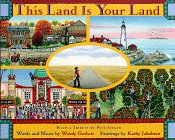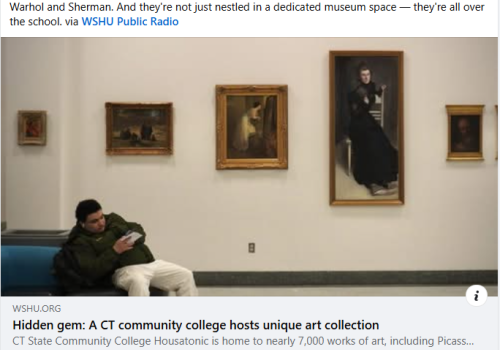
Innocence of Vision Artist of the People

Kathy Jakobsen: An Artist of the People
By Dr. Ruth MacDonald
Any reader of Kathy Jakobsen’s books can see that the pictures are the most important part of her work; the words and stories are second, except when she is the illustrator of someone else’s words, as she is in the Johnny Appleseed and This Land is Your Land volumes. She joins a distinguished crowd of successful children’s picture-book writers in starting with the illustrations: Maurice Sendak’s early career as a window dresser and illustrator of other people’s books is well documented. Chris van Allsburg [Jumanji and Polar Express] and David Macauley [Cathedral; Subway; Unbuilding] are both award-winning author-illustrators who began their careers with the illustrations, and were artists before they were authors.
What sets Jakobsen apart from these ‘grandfathers’ in children’s literature is the issue of training. Sendak is self-taught in the history of illustration, with little formal education in art, but with much study and grounding in other illustrators and artists. Macauley and van Allsburg are both professors at the Rhode Island School of Design, both having thoroughly immersed themselves in the technique and history of art; for both of them, writing and illustrating children’s books was a sideline that gradually became a major part of their professional lives.
For Jakobsen, the path to the art has been natural and tutored only by occasional study. Her style is called folk because that has been a major influence on her work—the ways of the American people, not the professional artist. If she has taken on similarities with other artists and writers of children’s books, the influence has been not because of studied flattery but rather because of natural affinity. When I first saw her books, starting with My New York, I was reminded of Dr. Seuss’s To Think That I Saw It on Mulberry Street [1937], as the book progresses each page becomes fuller and grander and noisier whereby at the conclusion of the story, the narrator’s imagination has filled a two-page spread with every character in a parade. In this same way, Jakobsen’s New York City is filled with people, buildings, and stars in the sky.
Listening to Jakobsen describe her illustrations, you realize that the work is highly personal, her family friends and acquaintances are included as are the legendary. For example, in View from the Pierre Hotel, 5th Avenue featured on the cover of My New York, celebrities such as Dr. Ruth Westheimer and former New York City Mayor Ed Koch make cameo appearances as do her own three children and strawberry blonde cat, Speedy. The people she knows and loves are always present in the pictures, illustrating the text. These are very personal books, drawn from personal experience and they depict only the kinder, gentler, sweeter side of life. References to the techniques of the greatest great masters such as Vermeer or DaVinci are not relevant.
This level of small detail, of people doing something that a child might recognize, is a technique also used in the Richard Scarry books for very young readers, such as his Busy World series. The comparison to the Where’s Waldo books has already been made by Frank Rich in a New York Times review. Everyone who knows about the presence of Jakobsen’s family and cat will be on the lookout for them on every page. No ‘reading’ of her individual illustration will be complete without siting these personal details.
And it is this level of detail, of people, buildings, and landscape, that gives Jakobsen’s books a sense of stillness and peace in the midst of extreme activity. The hard outlines of all her drawings nail the figure to the page and freeze it for close inspection. The page may be filled with all the bustling in the world—there’s a reason that New York is called the City that Never Sleeps—but the overall effect of Jakobsen’s rendering is peacefulness, calmness, of each person and figure doing what it needs to without being disruptive. Even the noisiness of a Disney World is calmed by the detail and arrangement of all the figures. Each element of every building recalls Macauley’s books about architecture, especially Cathedral and Skyscraper. But Jakobsen draws the buildings not so much for their architecture as for the enormity of their mass and for remembrance of them, especially in her illustrations of buildings of earlier times.
What Jakobsen has done in her large page is to borrow a technique of small book illustrators, like Beatrix Potter’s Peter Rabbit books. While each Jakobsen illustration is a whole, each part functions like a separate small page, drawing the reader in to observe it closely and carefully, as if each part were a small study in nature. This is a tactic that slows the reader down and draws the reader into the page, again reinforcing that peacefulness in the midst of bustle. The framing of the page with the tramp art borders of quilts, in Johnny Appleseed and This Land Is Your Land, further still the page and make the eye examine it in reflective tranquility.
Like Dr. Seuss, who was also not trained as an artist, Jakobsen has remarkable human forms, remarkable because of their lack of likeness to real people or other creatures seen in life. Imagine the Cat in the Hat with real joints, elbows and knees that have to work as they would in real life; this same untrained approach to drawing applies to Jakobsen, whose people walk and fill up the page, but who don’t seem to bend normally. Neither artist could do a real nude, though such illustrations are rarely called for in children’s books.
Unlike Dr. Seuss, Jakobsen can draw buildings and landscapes with remarkable precision and detail. In fact, it is these landscapes and cityscapes—and even seascapes-- that are the most memorable features of her works for children. Mostly folk artists take on rural scenes, and Jakobsen is adept at that. In fact, her use of the page that is much wider than tall in Johnny Appleseed, and the rolling landscape of the upper midwest recall Wanda Gag’s Millions of Cats. Gag pioneered this short, wide page in her own folktale, about the rolling hills of Minnesota; the same shape of hill is evident in Jakobsen’s Ohio hills in Johnny Appleseed, as well as in van Allsburg’s The Stranger, who is Jack Frost.
Where Jakobsen really challenges children’s illustration is in her book Meet Me In The Magic Kingdom. Of all the scenes in a child’ s life that have already been illustrated, photographed, and popularized, the view of the castle in the midst of Fantasy Land is surely one of the most widely known. It has been handled by Disney illustrators, animators, and imagineers for half a century that it has become an icon.
And yet Jakobsen takes it on, and makes it her own. The daily parade through Disney World becomes a tapestry not so much of Disney’s commercial tie-ins and incredible floats, but of American life and a combination of small town parade with kid fantasy. This is the small town Fourth of July parade of the nineteenth century detailed with elegance and dignity, rather than garish commerciality. Even Tomorrowland, that monument to the future and American inventiveness, has a quaint feeling to it because of the hard edges and unusual proportions. The illustrations look more like the Jettsons’ world, with 1950s quaintness, than the futuristic, well-groomed landscape that a real visitor sees. Jakobsen triumphs in capturing the fireworks display so frequent at Disney World. The display is captured with the static intricacy of needlework, rather than with pyrotechnic movement. Again, the result is pure Americana. Even the palette, emphasizing red, white, and blue, rather than Disney’s hot fantasy colors, underscores this message.
The sunny optimism of Jakobsen’s works for children contrasts directly with much of children’s literature in the late twentieth century. The realism of that genre of children’s literature that one wag called “my sister, the promiscuous drug-dealing anorexic” is nowhere present in Jakobsen. American accomplishment, the clean, crime-free world of a Disney World is as evident in that locale as in the streets of New York, at least according to Jakobsen’s rendition of them. This kind of cheery optimism has not been popular at the turn of this millennium, though it was much more in evidence at the turn of the 20th century, and in the children’s books of the 1950s.
World problems simply do not intrude themselves into her books, except at the end of This Land Is Your Land, where Woody Guthrie’s vision of a new world where there is enough for everyone, and no one is left behind is portrayed through community-based organizations to help the drug addict and the street person. While this kind of historicity is unusual in a Jakobsen book, it is absolutely true to Guthrie’s criticism of the culture of the 1930s. Being accurate in these details is part of the Jakobsen technique, and she could hardly have ignored Guthrie’s social criticism. In fact, the last few pages of this book are devoted to Guthrie’s biography, along with photographs to support the story. In this remarkable book, Jakobsen makes a transition from personal illustration to historian, committed to transmitting through her work the vision of another artist.
The labels of naive and primitive get attached to folk artists in a negative way. I’d prefer to think of Jakobsen as an artist of the people, from the people, for the people.
Dr. Ruth MacDonald
Academic Dean
July 6, 2001


